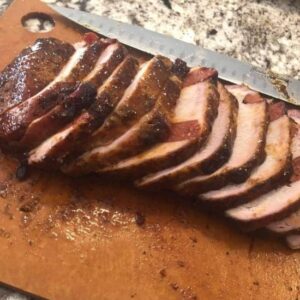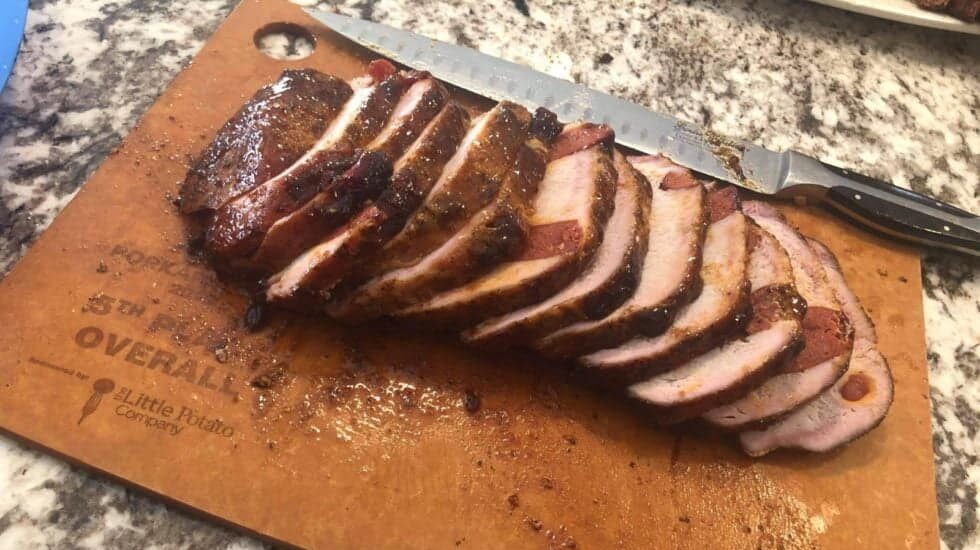Stuffed pork loin doesn’t have to be intimidating. Skip the butcher’s twine and complicated knife work—this Pepperoni Stuffed Pork Loin brings big BBQ flavour with a genius hack anyone can do. Juicy pork, smoky pepperoni, and a sweet BBQ glaze? Say less.
Pepperoni Stuffed Pork Loin
We’ve all seen those gorgeous rolled and tied stuffed pork loins from high-end BBQ joints. But what if you could get the same wow-factor (maybe more) with less gear and less guesswork? This method is pure BBQ ingenuity—just poke, stuff, season, and smoke. The pepperoni infuses the loin from the inside out, giving you smoky, savory flavor bombs in every bite. And when you slice into it and see those little pepperoni medallions inside? You’ll be hooked.
How to Make Pepperoni Stuffed Pork Loin
Preparation
Preheat your smoker to 275°F.
Pat the pork loin dry and lay it flat on a clean cutting board. Using a paring knife, make small cross-cut holes in the loin—poke the knife in, then twist 90 degrees to make an X-shaped opening. The holes should match the size of your pepperoni sticks.
Slide a pepperoni stick into each hole, cutting off the ends as they poke through the other side. Continue spacing your pepperoni every 1.5 inches along the loin.
Seasoning
Rub a light layer of mustard over the entire surface of the pork loin. This helps your rub stick and adds flavor without overpowering.
Generously coat all sides with Motley Que All Purpose Rub, then let the loin rest on the counter for about 20 minutes. The seasoning will begin to “sweat” into the meat for a deeper flavor crust.
Cooking
Place the loin directly onto your smoker grates and insert a temperature probe into the center. Smoke until the internal temperature hits 150°F. If you’re a stickler for USDA guidelines, you can go to 160–165°F, but remember that pork is safe at 145°F if properly rested.
In the final 5 minutes, brush the loin all over with your favorite smoked hickory BBQ sauce to glaze. Remove from the smoker and rest for 5–10 minutes.
Slicing
Use a sharp slicing knife and take your time—cutting crosswise into the loin reveals those beautiful rounds of pepperoni inside. If your pepperoni pops out while slicing, next time make slightly smaller holes. Serve hot with a drizzle of BBQ sauce and your favorite sides.
Best Beer To Pair With Pepperoni Stuffed Pork Loin
Amber Ale
Its malty backbone and subtle sweetness balance the smoky richness of the pork and spicy pepperoni.
Pilsner
Clean and crisp, a cold pilsner cuts through the fat and lets the seasoning and glaze shine.
Hazy IPA
A juicy IPA brings citrusy hops that complement the spice of the pepperoni and BBQ glaze without overwhelming.

Pepperoni Stuffed Pork Loin
Ingredients
- 4 each Fresh Pepperoni Sticks whatever flavour you prefer. I like Honey Garlic or Hot
- ½ each Pork Loin
- 1 tbsp Mustard
- ¼ cup Motley Que All Purpose Rub
- ¼ cup Yonedas Smoked Hickory BBQ Sauce
Instructions
- Preheat smoker to 275°F
- Pat pork loin dry and poke X-shaped holes
- Insert pepperoni sticks every 1.5”
- Rub with mustard and coat with all-purpose BBQ rub
- Let rest 20 minutes
- Smoke until internal temp hits 150°F
- Glaze with BBQ sauce and smoke 5 more minutes
- Rest 5–10 minutes before slicing and serving
Pepperoni Stuffed Pork Loin FAQs
Do I have to butterfly or tie the pork loin?
Nope! This recipe skips all that. Just poke holes, stuff pepperoni in, and you’re good to go—no fancy prep required.
Can I use other fillings besides pepperoni?
Absolutely. Try chorizo sticks, cheese sticks (cheddar or mozzarella), or even asparagus for a veggie-forward twist.
Is this recipe gluten free?
Yes—just double-check your BBQ rub, mustard, and sauce for gluten-free labels. Most pork loins and pepperoni are naturally gluten-free.
What internal temperature should pork loin be cooked to?
For juicy, safe pork, aim for 145°F and rest it for 5 minutes. You can cook to 150°F for a bit more doneness or 160°F if preferred, but avoid overcooking or it may dry out.
